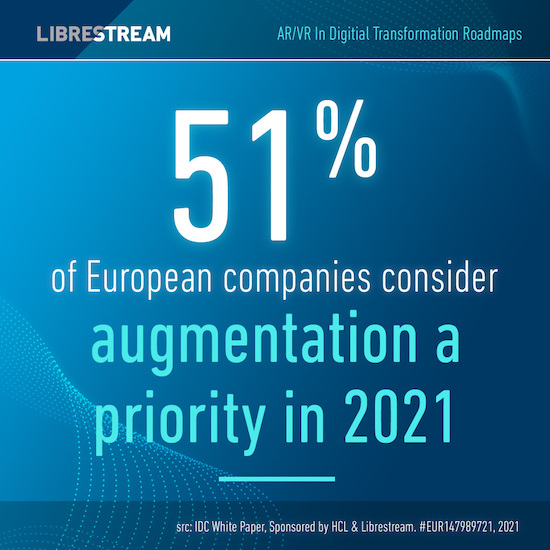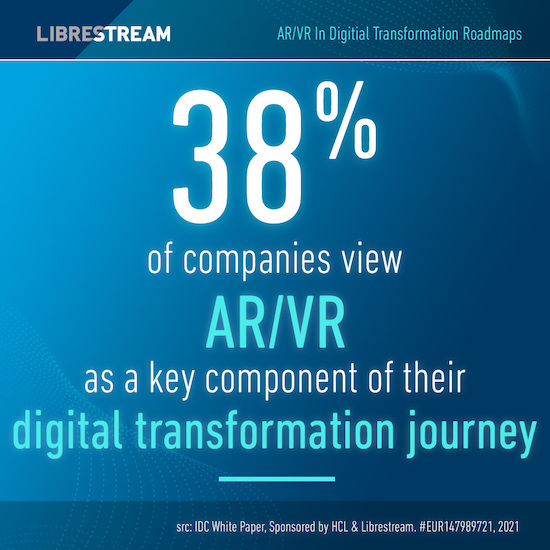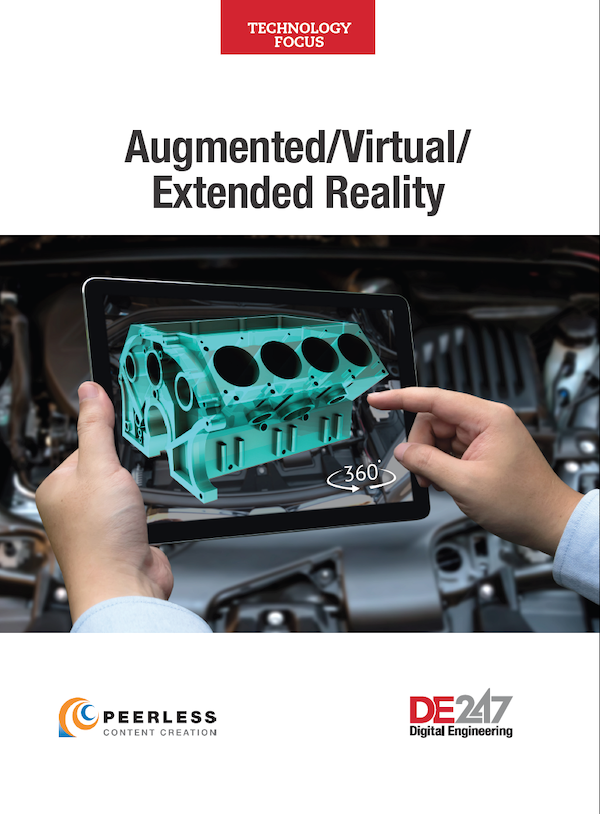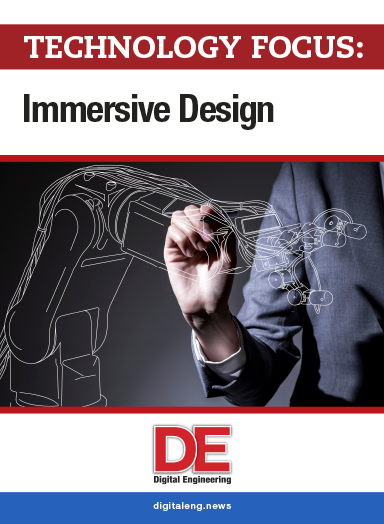AR Spending to Surpass $48.6 Billion by 2025
IDC report outlines how augmented reality is transforming remote work.

Latest News
September 28, 2021
Augmented reality (AR) is slowly emerging as a key component of many companies' digitalization strategies. During the recent pandemic, both AR and virtual reality (VR) were found to be helpful for a number of remote work scenarios. In the design and engineering space, these technologies have been used for design review and remote collaboration. Field service organizations are also increasingly using AR to provide access to repair and CAD files for remote engineers. These applications could potentially help further link designers to products in the field, expanding the concept of the digital thread and closing the loop between design and real-world products.
A new study from IDC (sponsored by Librestream, Onsight and HCL Technologies) predicts these use cases will fuel rapid growth in the AR space.
“AR is a key way that C-suites are achieving transformation at scale,” said Andrea Minonne, senior research analyst at IDC. “Spending on AR is expected to grow 18-fold over the next four years: from $2.7B in 2021 to $48.6B in 2025. Use cases will integrate AR with AI-centric products, IoT, new devices, and smart analytics to build knowledge networks that enable workforces to digitally access the data, people, and workflows that help them perform their work fast, efficiently, and safely.”
IDC provides an overview of the research in the whitepaper “Time to Start Your AR-Enabled Remote Workforce Transformation Journey,” and includes case study examples such as a European oil and gas company that reduced costs by 20% and a carmaker that reduced machine downtime and maintenance costs by 15% by using AR technology. In the automotive industry, downtime costs an average of $22,000/minute and with manufacturers losing 800 hours/year to downtime on average, the savings can add up to $13.2 million each month.
Reality Shift
According to the report, COVID-19, social distancing measures, and government requirements have created a “new reality” that has made augmented and immersive technology more appealing for remote workforce transformation, to enhance employee skills, and improve productivity of a dispersed workforce.
These trends have been echoed in other research, In a March 2020 report titled “Transforming Frontline Operations with Augmented Reality Technology,” the research firm LNS wrote, “AR enables a variety of high-value use cases such as remote expert access, digital work instructions, and in-context training that not only contribute to operational performance improvement, but also directly help to address the workforce skills gap challenges that threaten to hold back manufacturing and other industrial sectors.”
IDC's IT Buyer Sentiment Survey found that AR adoption is growing, with 64% of companies maintaining or increasing their spend this year to achieve measurable corporate outcomes, improve return on investment, and drive corporate success.

In addition, IDC's Vertical IT and Communications Survey, 2020, indicates that an increasing number of companies (38%) see augmentation technologies as a key component of their digital transformation initiatives.
AR can be used for maintenance, retail, and logistics applications, augmented by technologies like artificial intelligence (AI), machine learning (ML), and natural language processing. The COVID-19 pandemic increased demand for AR solutions that helped workers stay and carry out routine collaborative tasks.
In field service and repair, AR solutions allowed for “connected expert” applications, where more experienced technicians could help new hires in real-time. IDC believes this will shift to an “AI-connected expert” workforce with the integration of AR and AI.
“This is because the need to capture and share knowledge in the workforce will never be more critical to achieve ever-changing priorities and KPIs. Currently, as much as 80% of a business' knowledge remains undocumented,” the report states.
Use Cases
AR is being used in manufacturing, disrupting product design and prototyping process enhancements to R&D departments, AR-based visualization tests and data validation to product development and analysis departments, and remote industrial maintenance to field technicians.
According to the report, in 2020, AR was able to assist manufacturers with remote maintenance/repair, inspection and fault detection, virtual demonstrations, as well as onboarding, on-the-job training, and upskilling. According to IDC's 2020 Industry IT and Communications Survey, 33% of discrete manufacturers are using AR and VR to increase safety for their employees, while 32% are using the technologies to increase collaboration.
The report identified several key use cases for AR. One was the aforementioned field service application, via remote service guidance. Global spending on AR-enabled industrial and asset maintenance and onsite assembly and safety will reach $1.5 billion in 2022, according to the report.
Automotive companies are using AR to help automotive technicians carry out complex maintenance tasks and optimize prototyping and assembly tasks via interactive manuals and step-by-step guidance on mobile devices or wearables. The aerospace industry is also leveraging these same approaches for maintenance and inspection.
According to IDC, by 2025, utilities will spend $2.5 billion on AR solutions and industrial maintenance, and will continue to innovate at scale to support this trend. AR is facilitating employee training across the energy sector, supporting knowledge transfer and enhancing safety practices.
AR-enabled training and support is another emerging application. This includes creating augmented environments for employee training, support, and upskilling. Global spending on AR-assisted training alone will reach almost half a billion dollars in 2025. IDC's 2020 Industry IT and Communications Survey shows that 31% of automotive manufacturers describe their intended use of AR or VR technologies today to be for employee training.
Lightweight 3D model viewers, a regular feature of Product Data Management (PDM) and Product Lifecycle Management (PLM) solutions, are also gradually moving toward AR/VR. In 2019, Terex, a U.S. manufacturer of drilling machines and construction equipment, partnered with the 3D collaboration software developer Vertex to improve collaboration with its customers.
“We’ve given the ability to view and interact with 3D models to a more diverse group of users within our customer base to satisfy their needs for design reviews,” said Ryan Kloos, Sales Application Supervisor, Terex. “By providing more detailed information for customers to review, that minimizes confusion and rework. We’ve found that with Vertex, the customer experience has vastly improved and we can accelerate our cycles.”
These use cases exemplify how engineering data, maintained as detailed CAD models, are now finding new uses among the frontline technicians with limited exposure to CAD. The use of AR/VR-powered remote applications have been gradually replacing the paper manuals and PDF instructions, but the pandemic appears to have accelerated the shift. The trend is of interest to software developers like PTC, Autodesk, Dassault Systemes, and Siemens, which offers both CAD and PLM products.
For some field workers in refineries, manufacturing plants, and power plants, a lightweight tablet loaded with animations and annotated 3D models might serve as repair and instruction manuals, but for the crews working on the Orion spacecraft from NASA, a different solution is required.
Lockheed Martin’s solution to this was Hololens 2 headsets from Microsoft. “They didn’t have to refer back to a computer screen or paper drawings during that entire activity,” said Shelley Peterson, Lockheed Martin Principal Investigator for AR. “Out on the shop floor they can put on the HoloLens 2 device, power it up, and it has all the content that they need to figure out how to do that task overlaid right there on the structure.”
Peterson estimated that AR reduced touch labor by 90%. As a result, “We’re now completing 8-hour activities in just 45 minutes,” she added.
In automotive and aerospace, AR/VR-based design review and training is gaining ground. Varjo, which counts Kia and Volvo among its customers, recently made public the details of its involvement with Boeing for the Boeing Starliner project, jointly developed by Boeing and NASA.
The spacecraft launch into orbit involves a complex sequence of commands. Part of the astronaut training is practicing these operations in simulation over and over to eliminate potential mechanical and human errors during the real event.
“When the first crewed mission aboard CST-100 Starliner takes place, the crew will have banked hundreds of training hours for each phase of the entire mission—including launching, docking, re-entering the atmosphere and landing phases—using Varjo’s human-eye resolution VR devices,” the company wrote.

Technology Transformation Milestones
The report identifies a number of technology transformation milestones that can be helpful in deploying AR and other immersive technologies.
First, companies should assess their corporate digital readiness. That includes assessing their level of corporate digitization, remote workforce culture, and employee level of technology acceptance and usability, along with IT concerns.
Second, they should define clear goals for the AR-enabled solution built around measurable KPIs and business outcomes. Third, they should build a road map for the project, including financial sustainability goals.
Fourth, companies should build an ecosystem that allows stakeholders to provide feedback. The AR-based solution should encourage interaction and collaboration across roles. Companies should also directly involve the affected workforce in the transformation process, giving them input on how the technology is deployed and used.
Finally, companies should invest in educating their workforce so that they have the right skills and knowledge to make the deployment a success.
According to the report:
“Industries around the world are already using AR for a wide range of use cases and if you are aiming to increase workforce productivity, decrease the number of onsite inspections, increase cost savings, resolve issues faster, and reduce the amount of travel for technicians, you should consider starting your AR journey.”
Subscribe to our FREE magazine, FREE email newsletters or both!
Latest News
About the Author
DE’s editors contribute news and new product announcements to Digital Engineering.
Press releases may be sent to them via [email protected].






